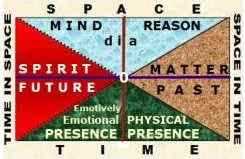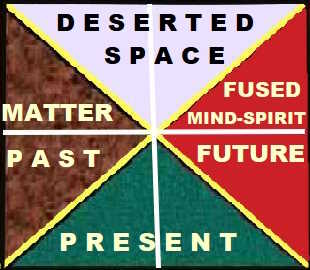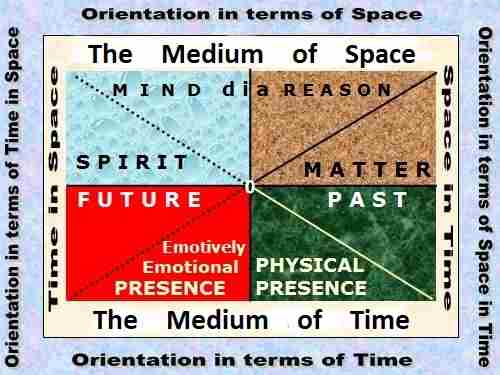What is Time?

Dialectical Creative Framework for Orientation in the Eternity of Times DIA Infinity of Spaces
In spite of enormous efforts of the greatest minds to answer this question, it turned out, the mega-dialect time is extremely complex and difficult to fully understand, elaborate and explain. In order to bypass the direct response to this question without a definite answer, all known concepts of the time were reflected through the prism of the mega-dialect space. Reason for using this approach is simple. Namely, this reflection and manifestation of the dialectically fraternal [evolving from two eggs/haploid gametes] dia identical (emerging from one egg) twins puzzle (time and space), as an outcome of the dialectical interplay of constituent dialects of the time, in time DIA space, is much easier to observe and perceive by five basic senses. As a consequence of this approach, the symbiotic concepts of space and time emerged, such as the Newtonian concept of the public space and public time (fraternal aspect of the twins puzzle), as well as the concept of the space-time (identical aspect of the twins puzzle), proposed by Albert Einstein. By writing about time, Saint Augustine (354-430) excellently expounded this complex topic in a creative way: "What then is time? If no one asks me, I know what it is".
- Reconsidered from the perspective of the dialectical understanding of time DIA space, this means, he feels his inner (OWN) time (in the spiritual sense), and for this reason, he understands and knows what (this aspect and manifestation of the) time is (future dia spirit: TIME IN SPACE).
"If I wish to explain it to him who asks, I do not know".
- In other words, he is not able to situate and extend this inner feeling of time in EXTERNAL terms in order to explain this in the same way to others.

The Cheops Pyramid in Egypt
The dialectical understanding of time [future (within thee), emotively emotional dia physical presence, past (around thee)] DIA space [spirit, mind dia reason, matter], which is based on the pre-ancient hidden knowledge, revives and introduces, apart from the dialect time in space (future dia spirit), the dialect: space in time (matter embedded in the past). Actually, only this aspect and the manifestation of the EXTERNAL time DIA space is observable and understandable because this is perceivable by meams of five basic senses, and for this reason, this is explainable (in the scientific terms) too. More about this, in other parts of this creative article will be said. By deducing, translating and adapting (simplifying) the dialectical understanding of time DIA space in terms of the rectilinear way of understanding of space (matter ⇢ reason ⇢ mind ⇢ spirit) and time (past ⇢ physical presence ⇢ emotively emotional presence ⇢ future), it is perceivable that as rectilinearly is moved farther from the left to the right pole of this imaginative line as more difficult its constituent parts (dialects) is to understand, and thus to EXPLAIN. In other words, the dialect-matter (an aspect and manifestation of space) and the dialect-past (an aspect and manifestation of time) is easiest to understand and explain, while the most difficult (if feasible at all?) is to fully understand the dialects: spirit and future, and for this reason, to explain them. The reason for this is easy to explain. Namely, on this imaginable line of the presented dialects in this rectilinear way, the realm of the dialect-mind dia reason is left behind, which is of the crucial importance to perceive, become aware of something, as well as to grasp and understand the different ways in which time, in time DIA space, manifests and occurrs (appears).
|
Source: Proposal for a Potential Ph.D. Dissertation at the Copenhagen Business School, Denmark: |
In short, without some kind of manifestation of the medium of time DIA space [mind dia reason DIA emotively emotional dia physical presence], there is also no way to understand and explain anything (inner) in the external sense and vice verse. For this reason, to solve the dilemma whether space (and time) can be perceived without some kind of manifestation of the dialect-mind (dia reason), as well as to encompass these enormous inner vastnesses, in this pre-ancient understanding of time DIA space, the dialect-mind dia reason (the medium of space) was included as the constituent part of the mega-dialect - space. From this follows that the mega-dialect space is only slightly more understandable compared to its twin brother time, exactly because their common interactively creative outcome, space in time (matter embedded in the past) is more easily perceivable (by means of five basic senses), and for this reason, this is also more easily understandable by mind dia reason too, and then externally explainable to others in comparison to the dialect time in space (future in spirit). In either way, the moral lesson of this phenomenon and the paradox of time, excellently expounded by Saint Augustine, is that the mega-dialect time can be understood without further explanation, at first place, to those who also possess (have preserved) their inner (own) time. This creator of knowledge hopes that after reading all parts of this creative article everyone will become more familiar with this very complex topic because thinking DIA dialectical synthesizing in terms of four dialects [the medium of time, the medium of space, time in space, space in time] by means of common (healthy) sense, compared to doing this with two dialects (space and time)
- this per definition leads to the known traps of the bipolar dia binary way of thinking,
is far more appropriate for the overcoming physical boundaries, limits and related mindual ("mental") distances in the way of thinking
- a gap between evil-minded versus good-minded, dark-minded versus open-minded, narrow-minded versus broad-minded, small-minded versus fair-minded, absent-minded versus common sense-minded, egoistic-minded versus aware of the human prick of conscience, minded and then being redirected by it,
which actually separates the more tangible external (matter-like) dialectical worlds from the inner (spiritual) worlds of dialectics. This rectilinear process of separation versus strong gravitational force of 'attraction' ('bridging') can go that far, as an utmost result of the bipolar versus the binary way of thinking (yes-no, true-false, on-off, EXTERNAL-INNER), that the aforementioned gap completely 'disappears' by being continuously marginalized over the passage of time and space until it becomes completely ignored, for one or another incentive. For a broader creative framework of this topic under creative reconsideration, read the creative article: Puzzle of Space and Time.
What means Time: Traditional VERSUS Dialectical Understanding of Time

(Recti)linear Creative Framework for the Orientation in Time AND Space, reinterpreted from the Perspective of Dialectical Understanding of Time DIA Space
In the traditional understanding of time, in full agreement with the rectilinear way of thinking, (my, your, our) physical presence moves through time like a bead sliding on a wire (the river of time). Using this analogy, in the linear and circular way of thinking, the time was understood and presented as the concept of the wheel of time. However in the living reality, seen from the dialectical perspective, the dialect- [emotively emotional dia physical] presence cannot be authentically presented (and interpreted) by using this simple (recti)linear way of the understanding of time (past ⇢ present (time) ⇢ future), because the dialects future and the past are also dialectically encountered, "(counter-)copied DIA metamorphosed" with each other, depending on the INTENTIONALITY and the intentions of the present participants in the initiated dialectical processes, and as such ones they were intermingled and merged in an imaginative point-puncture (pore DIA spore), understood in the sense of time in space DIA space in time. Bear in mind, although all details of the dialect-future cannot be created, and for this reason the future flow of events cannot be fully predicted, in normal set of circumstances there is a broader structure of the future (key-, crucial and essential future events), and therefore it can be anticipated continuation of functioning this general structure of the future course of events, both within the societal universe
- [the realm of the five basic senses (of the present time): birth, youth, mature age, old age and the death of the living beings and things, the course of seasons and the like]
and in the macro-universe, understood in terms of the corresponding life-cycles of the stars, galaxies.... More about this can be read in the creative article: Puzzle of Time and Space - PRIMARY LAW OF DIALECTICS. Anyway, as a result of this dialectical transformation of the dialects future and past within this pyramid of the ongoing flow of time DIA space, this over and over created, reestablished and renewed pore-spore, which encompasses and prevails dialectical distances between the constituent parts of these four mega-dialects
- {pore ["now (with)in there": emotively emotional presence understood in terms of time in the space]
DIA - spore ["now in(side) here": physical presence understood in terms of space in time]}
is large enough to play the role of a temporal medium of presence (of something, of someone) understood in the sense of this dialectical way of understanding the time (DIA space). This very moment DIA the initiated dialectical interactive processes of the time in space (future in spirit) and space in time (matter embedded in the past) within the considered span of time DIA space was in dialectical sense presented by a dialectical synthesis, that was symbolically represented by an ellipse (egg, "zero": soon dia almost nothing), and located within the core of this inter-crossed symbol for the eternity of times DIA infinity of spaces (8 DIA ∞) of these four inter-complementary dialects: the medium of time, the medium of space, time in space, space in time. In other words, seen from the dialectical perspective, the dialect (of the emotively emotional dia physical) presence actually presents an imaginative point in time, where the future and the past are dialectically encountered, understood in terms of time in space DIA space in time. To sum up briefly, the mega-dialect time, because each of its three (3) constituent dialects was also presented in terms of dialectical synthesis of the other two dialects, can be understood in the sense of a continuous dialectically creative multi-interplay of the dialects - future, emotively emotional presence dia physical presence, past. In the creative article, that follows this one, some other (linear) aspects of time DIA space will be reconsidered through the prism of this pyramid (of life).
Apart from this previously mentioned, even the modern science, properly understood (Olber's paradox), contradicts this (recti)linear comprehension and understanding of the mega-dialect TIME. According to this scientific view, my - thy - our PHYSICAL PRESENCE is surrounded from all sides by the dialect - (matter in the) past, and not only from behind me, thee, us. But these (external) experiences and limitations of the rectilinear understanding of time and space ARE NOT ALSO VALID FOR THE DIALECT - EMOTIVELY EMOTIONAL PRESENCE! In other words, only this kind of the dialectical SPIRITUAL (creative) presence can prevail these physical limitations, and peer into the INVISIBLE INNER EXPANSES of this way of dialectical conceiving, comprehending and understanding of (the dialect -) FUTURE, respectively, into the immense expanses of dialectical worlds of TIME IN SPACE: future IN SPIRIT. After this observation, based on the dialectical way of understanding of time DIA space, emerged on the light of day, all (methodological) shortcomings and (creative) disadvantages of the exclusion of dialect - spirit from the 'modern' scientific thought, generally speaking, as a result of the implementation of the contemporary scientific methodological approaches, only because the dialect - spirit is objectively (and mathematically completely) immeasurable, and for this reason physically meaningless.
Seen from this methodological perspective, the major dilemma in this case is: Where in this constellation of time is the DIALECT - FUTURE? As it will be elaborated in more details in other creative articles, the dialect - future depends on the intentions and intentionality of (all) present key-actors, higher (heavenly and natural) forces and the like. In order to be correctly understood this dialectical content in DIALECTICAL terms, that means, to be avoided traps of the rectilinear (bipolar) DIA binary way of thinking (black-white, yes-no, 0-1), another important mega-dialect should also be presented: SPACE, which will be considered and elaborated in the next part of this creative article. In other words, any consideration of the term TIME without the notion of SPACE and vice versa does not make any sense in the dialectical way of thinking, precisely because of the basic interactively creative features, aspects, attributes and manifestations of the time DIA space, without which the way DIALECTICS works in the reality of life is impossible to imagine and understand, that is, WORLDS OF DIALECTICS, which are in a state of continuous CHANGE, although in small spans and intervals of the time-DIA-space this is not always clearly observable. From this follows, the medium of the mega-dialect-time, that is, the physical presence dia emotively emotional presence, cannot be separately considered without the suitable spatial medium: mind DIA reason. In short, these inner [time - in - space(like)] aspects of the dialect - future (WITHIN THEE) will be considered in more details in the creative article: Dialectic Interactive Approach: The Concept of the Dialectical Understanding of Time DIA Space versus The Concept of (Recti)linear Understanding of Space and Time, as well as in the chapter of the creative article: Dialectical Comprehension of Future. Note also, throughout the introduced dialectic interactive approach the notion - DIALECT was used instead of the notion - (constituent) part in order to emphasise the inseparable dialectical INTERACTIVELY creative aspects, properties and manifestations of the mega - dialects time DIA space, as well as an affinity of linguistic features of some closely interrelated dialects of time, in time DIA space during initiated dia-processes of (multifaceted) interaction, behaving similarly to closely related dialects (constituent parts) of a language (whole).










